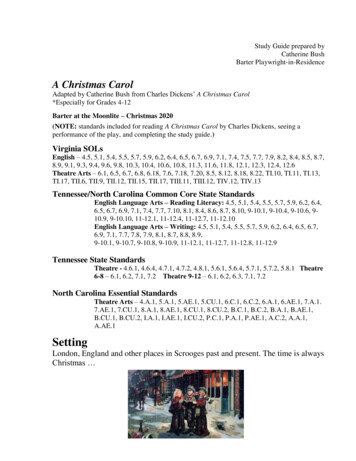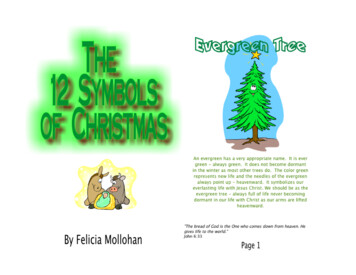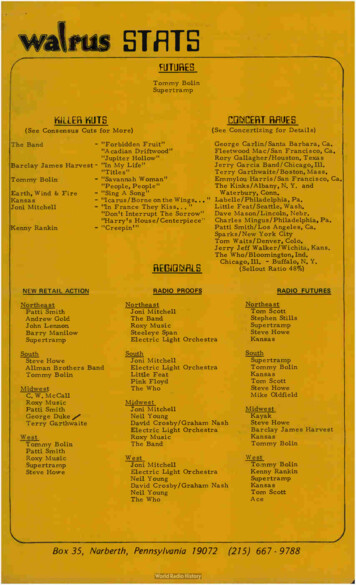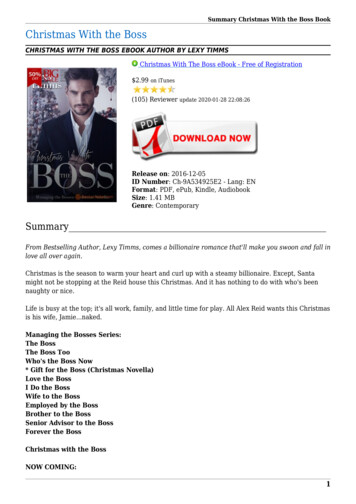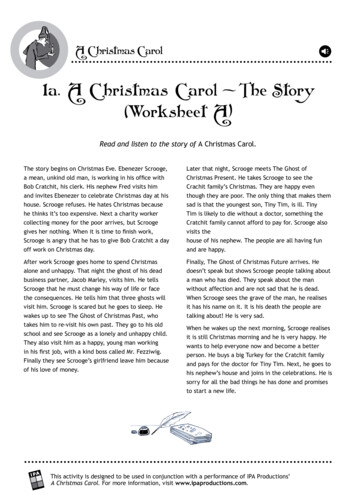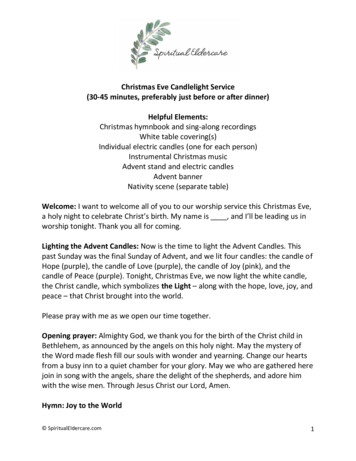
Transcription
THE MAN WHOINVENTED CHRISTMASDirected by Bharat NalluriStarring Dan Stevens, Christopher Plummer andJonathan PryceUK release date 1st December 2017Running time 104 minutesCertificate PGPress information Saffeya Shebli saffeya.shebli@thunderbirdreleasing.com 020 7377 14071
OFFICIAL SYNOPSISThe Man Who Invented Christmas tells of the magical journey that led to the creation ofEbenezer Scrooge (Christopher Plummer), Tiny Tim and other classic characters from AChristmas Carol. Directed by Bharat Nalluri (Miss Pettigrew Lives for a Day), the film shows howCharles Dickens (Dan Stevens) mixed real life inspirations with his vivid imagination to conjureup unforgettable characters and a timeless tale, forever changing the holiday season into thecelebration we know today.LONG SYNOPSISThe bestselling writer in Victorian London sets out to revive his flagging career and reimaginesYuletide celebrations in The Man Who Invented Christmas, an entertaining and enchantingglimpse into the life and mind of master storyteller Charles Dickens as he creates thequintessential holiday tale, A Christmas Carol.After a string of successful novels, world-renowned writer Dickens (Dan Stevens) has had threeflops in a row. With the needs of his burgeoning family and his own extravagance rapidlyemptying his pockets, Dickens grows desperate for another bestseller. Tormented by writer’sblock and at odds with his publishers, he grasps at an idea for a surefire hit, a Christmas story hehopes will capture the imagination of his fans and solve his financial problems. But with only sixweeks to write and publish the book before the holiday, and without the support of hispublishers – who question why anyone would ever read a book about Christmas – he will haveto work feverishly to meet his deadline.Dickens locks himself away to write, but his chaotic household, which now includes his profligate father (Tony winner Jonathan Pryce), is a constant distraction. Working late into thenight, the writer channels his own memories to conjure up the ghosts of Christmas Past, Presentand Yet to Come, and place them on a collision course with the misanthropic miser Ebenezer Scrooge (Oscar winner Christopher Plummer).Based on Les Standiford’s 2008 book, The Man Who Invented Christmas: How CharlesDickens’s A Christmas Carol Rescued His Career and Revived Our Holiday Spirits, the moviebrings the imagination of one of the world’s best-loved authors to vivid reality as he creates themasterpiece that has shaped modern-day Christmas celebrations for more than 150 years.The Man Who Invented Christmas is directed by Bharat Nalluri (Miss Pettigrew Lives for a Day).Screenplay is by Susan Coyne (“Mozart in the Jungle,” “Slings and Arrows”) and is based on thebook by Les Standiford. The film stars Dan Stevens (“Legion,” Beauty and the Beast),Christopher Plummer (Beginners, A Beautiful Mind), Jonathan Pryce (The Man Who Killed DonQuixote, Pirates of the Caribbean: Curse of the Black Pearl), Justin Edwards (Love & Friendship,The Thick of It), Morfydd Clark (Love & Friendship, The Falling), Donald Sumpter (“Game ofThrones,” The Girl With the Dragon Tattoo), Miles Jupp (Journey’s End, The Monuments Men)and Simon Callow (The Rebel, Victoria and Abdul) with Miriam Margolyes (The Age of Innocence,Romeo Juliet), Ian McNeice (Ace Ventura: When Nature Calls, White Noise) and Bill Paterson(“Fleabag,” “Churchill’s Secret”).The film is produced by Robert Mickelson (Hard Choices, Traveller), Ian Sharples (Cruel andUnusual, The Color of Magic), Susan Mullen (Brooklyn, Albert Nobbs), Niv Fichman (Enemy,Blindness) and Vadim Jean (The Color of Magic, Leon the Pig Farmer). Executive producers arePaula Mazur (Nim’s Island; Corrina, Corrina), Mitchell Kaplan (Delirium, “One Christmas Eve”),Andrew Karpen (Logan Lucky, Captain Fantastic), and Laurie May (Indian Horse, Choke).Director of photography is Ben Smithard (Goodbye Christopher Robin, The Damned United).Production designer is Paki Smith (The Dark Knight Rises, Free Fire). Editors are Jamie Pearson(King Arthur, MI-5) and Stephen O’Connell (“Howards End,” Maudie). Music is by Mychael Danna(Life of Pi, Little Miss Sunshine). Costume designer is Leonie Prendergast (Love, Rosie, WhatRichard Did). Hair designer is Lorraine Glynn (Brooklyn, Bloody Sunday). Make-up designer isSonia Dolan (The Hobbit trilogy, “The Tudors”). Casting director is Amy Hubbard (The Hobbit,The Lord of the Rings).2
ABOUT THE PRODUCTIONCharles Dickens’ slender volume, A Christmas Carol, has fascinated and delighted readers,artists, playwrights and filmmakers for almost two centuries with its themes of family,benevolence, goodwill and festivity. In fact, it set a new standard for the holiday, inspiring thespirit of the traditional Victorian Christmas and beginning a host of customs that are stillpopular today. But while most readers are familiar with the beloved tale, few know the storybehind it.Les Standiford, author of the book that inspired the film and a prolific fiction and nonfictionwriter in his own right, learned A Christmas Carol was almost never published. “I had no ideathat he had to pay for the publication himself,” he says. “Even though no publisher wasinterested in it, the book was responsible for changing the trajectory of Dickens’ career. I setabout to find a book that explained it all, but to my great surprise, there was no such book.”So Standiford decided to write one himself. A fascinating peek into the creative process of oneof the world’s greatest storytellers, it was quickly optioned by producer Robert Mickelson andexecutive producers Paula Mazur and Mitchell Kaplan. All Dickens buffs, like many involved inthe making of The Man Who Invented Christmas, they discovered Standiford’s meticulouslyresearched account of this period in the author’s life about eight years ago. “Paula and Mitchgave me the book,” recalls Mickelson. “It was a story we weren’t aware of at the time andexploring Dickens’ creative process as well as his life fascinated me.”Kaplan says, “as a bookseller for 35 years and a good friend of Les’, I knew that his delightfulretelling of how Dickens brought his classic to print resonated deeply with readers, and if weput the right pieces together we would create something very special for moviegoers, as well.”For Mazur, the book offered a new perspective on A Christmas Carol. “In 1843, at age 31, Dickenswas a literary rock star, which makes the story feel very contemporary,” she says. “He waswildly successful and was plagued by all the issues that are attendant to that.”Published in 1843, A Christmas Carol was a last-ditch effort by Dickens to raise money tosupport the affluent lifestyle he and his family had grown used to. But the lavishly illustratedvolume turned out to be more than just an instant moneymaker. It also renewed interest in, andenthusiasm for, a holiday that had fallen into disfavor.There have been other Dickens biopics over the years, but The Man Who Invented Christmasfocuses on the intense six weeks during which he wrote and self-published A Christmas Carol.The filmmakers envisioned a screenplay that presented Dickens as a modern man: flawed, fierceand funny all at the same time. Writer Susan Coyne, co-creator of “Slings and Arrows,” aCanadian TV series about a modern-day Shakespeare theater festival, had made an impressionon Mickelson with the offbeat sensibility she infused into the show. “Her writing has a charmand character to it, as well as a great deal of humor,” says Mickelson. “I am a big fan.”Coyne delivered a playful narrative in which Dickens interacts with his fictional characters as hegives birth to the tale of Ebenezer Scrooge. In Coyne’s screenplay, Dickens has longconversations with his creations as their stories unfold in front of him. “The characters becomereal to him,” she says. “We know that Dickens did carry on conversations with his characters, sothat is based on the true story and we’ve invented his interior thoughts. He often talked aboutthe characters in his plays and books being more real to him in some ways than the people inhis own life.”Coyne identified with the anxiety creative people often feel when they are under the gun.“Dickens was down and out at this point,” she says. “He’d had all these big successes like ThePickwick Papers, Nicholas Nickleby and Oliver Twist. And then he had a few flops. The more Iread about him, the more fascinating he became. He was such a mixture of ambition, humanity,pettiness and largeness of spirit — a complex and remarkable person.”Struck with writer’s block, Dickens develops an adversarial relationship with his characters,especially Scrooge. “Scrooge becomes his nemesis,” says Mickelson “And Dickens becomes a3
character in the story that he’s trying to write. It’s like he’s entered his own Dickensian novel.There are many layers woven into this tale.”The script instantly attracted the attention of producer Ian Sharples of The Mob Film Company.“It’s always about a gut reaction to material for me,” he says. “The Man Who Invented Christmashas an element of modernity about it. Even though we’re dealing with a real person from morethan a century ago, Dickens seems familiar, and for me as a filmmaker, his journey is veryfamiliar. The struggle of getting a piece of literature into the book shops in his day was just ashard as getting a feature film made today.”Director Bharat Nalluri, best known for the charming period comedy Miss Pettigrew Lives for aDay, was selected to helm the film. “Bharat has a lightness of touch,” says Mickelson. “He getsgreat performances from his casts. We thought he would bring a perfect balance and captureboth the humor and the energy of Dickens.”Nalluri was impressed with the many layers of meaning with which Coyne infused thescreenplay. “It’s a rare treat to get a script that’s so fully formed,” he says. “It’s a fun, enjoyablepiece with great characters and visual flare. Underneath it all, it has a little something to sayabout the world we live in. In a way, it takes after Dickens, who created these larger-than-life,often very comedic characters and used them to tell stories that delivered a profound impact onsociety and were fun to read.”With only a short time to shoot and a complex story to tell, Nalluri proved an able leader. “He isjust fantastic,” says Mazur. “We had a lot of visual strands that had to be pulled together. He isone of those rare directors who is equally in command of the visuals and the story. Bharat wasable to wrap his head around all of that and track it through a pretty complicated, fast shootingschedule. He also worked extremely well with the actors.”Standiford, who spent time on the film’s Dublin set, was thrilled to see the story come to life onscreen. “These filmmakers have brought the essence of the book out in the film and that’sparticularly gratifying,” he says. “I think people who see this production are going to beentranced by it.”They will also be entertained and amused, says Susan Mullen, the film’s Irish producing partner.“It’s funny, it’s heartfelt. I think what Dickens wanted was for us take it upon ourselves to bemore generous. That we should lend a hand, that we must care for others — it’s a beautifulmessage. And it really did change the way everybody viewed Christmas.”CREATING UNFORGETTABLE CHARACTERSSome of the U.K.’s most distinguished actors agreed to take on large and small roles in The ManWho Invented Christmas. Casting, says Mickelson, always starts with the script, and when agood one comes along, people line up to participate. “To our delight, a lot of great actors out ofLondon had read it and were eager to come even for a day. It was quite remarkable. And wheneach one arrived, they brought something new and wonderful to the table.”Just 31 years old when he wrote A Christmas Carol, Dickens was still a dashing young man abouttown. With that in mind, the filmmakers offered the role to Dan Stevens, known to millions of“Downton Abbey” fans as the ill-fated heir Matthew Crawley. Instead of the gravitas associatedwith the older Dickens, Stevens invests the role with youthful energy, charisma and curiosity.“It is such a charming script,” the actor says. “This isn’t a reverential biopic. It’s the story of agifted artist’s creative drive and the pressure he puts on himself to produce. At the time,Dickens had four kids and one on the way. I also had one on the way when I was reading this, sothat resonated with me. And it explores the complicated relationship with his father and thestory of how one of the greatest books of all time was written. A Christmas Carol reallypermeates the culture in a way that no other Christmas story does — except perhaps theNativity itself.”4
Nalluri describes Stevens’ performance as “jubilant, exciting and dynamic — which Dickens was.He was a man always on the move. Dan tapped into that and delivered a wonderful, verymodern take that really drives the whole movie. I think he was born for this role.”For anyone who only knows him from “Downton Abbey,” says Sharples, Stevens’ performancewill be a revelation. “He is in pretty much every scene. That is a lot to rest on one person’sshoulders, but he is incredible. He always brought full-on energy and enthusiasm to the set.”To prepare for the role, Stevens turned to several well-respected studies of the author, includingBecoming Dickens, written by Robert Douglas-Fairhurst. “It is really about the period just beforeour film. It’s less the venerable Dickens we all know and revere, and more a witty, ambitious, upand-coming writer. I also read Michael Patrick Hearn’s annotated edition of A Christmas Carol.Some of the details that made their way into the film, like the way he stood in front of a mirrormaking faces and doing odd voices, come from letters written by his friends and family.”Playing opposite Stevens as his creation and seeming nemesis, Ebenezer Scrooge, is Academy Award winner Christopher Plummer. A character whose name has become synonymous withbitterness and greed, Scrooge has rarely been played with so much charm. “I can’t imagineanyone better for the part,” says Coyne. “Christopher captures both the menace of Scrooge anda tremendous warmth and dry humor that humanizes the character.”Plummer’s approach to the role is unique, says Mazur. “It’s a quiet and tense Scrooge with veryfunny moments. Chris found a way to make him Dickens’ alter ego, the part of Dickens that hedisliked about himself.”Stevens agrees, adding, “Christopher discovered something really different and interestingabout the character. He’s kind of sweet and mischievous.”Plummer has been involved with the project since almost the beginning. “Susan Coyne createdan extraordinary and magical story for a film,” he says. “When I was asked if I would be in it, Isaid damn right I will. I’ve been a lucky guy. I’ve played so many of the great parts, but neverScrooge. It seems like an obvious follow up to King Lear.”An avid “Downton Abbey” fan, Plummer has nothing but praise for Stevens. “He was charmingin that and very good in a very complex role,” the actor says. “He’s perfect for Dickens — both inhis look and the way he attacked the role. Charles Dickens was not always a very nice man andDan found all the colors.”Plummer has equal regard for Nalluri, who he says deftly handled the movie’s humor. “Directorsdon’t always have a theatrical sense of humor. I was very pleasantly surprised. He’s a very funnyguy with a lovely twinkle and he’s obviously very talented.”The legendary actor’s presence on set created excitement for even the most seasonedfilmmakers. Nalluri says he has been waiting to work with Plummer since he was 12 years oldand saw The Man Who Would Be King. “It was very special,” he says of directing his longtimeidol. “I didn’t really have to do much. We all sat in awe as he delivered his lines and then walkedoff set. He pretty much nailed it every time.”According to producer Mullen, Dickens’ relationship with his father, John Dickens, underpins theentire narrative. Believed to be the inspiration for David Copperfield’s spendthrift Mr. Micawber,John Dickens was a flamboyant character who survived by his wits — and was a greatdisappointment to his son. He ended up living on Dickens’ name, selling off scraps of writingfrom the trash.“Although Dickens adored his father, he often felt betrayed by him,” Mazur says. “When hisfather ran out of money, he forced young Dickens to work in a horrid shoe polish factory.Dickens was Oliver Twist. So we created a triangle between Dickens, his father and Scrooge, inwhich Scrooge forces Dickens to come to terms with his father in order to finish A ChristmasCarol.”5
As John Dickens, Jonathan Pryce exudes breezy confidence and bonhomie, making it difficult todislike the man or to judge his actions. “Jonathan walks this fabulous, razor-thin line of, ‘Is hedoing the right thing or not?’” says Mickelson.Pryce did some preliminary research into the life of the elder Dickens, but his experience playingreal-life characters has taught him always to rely on the script as his primary source. “What youalways want to do is fulfill the screenplay,” he explains. “The character has to stand up in hisown right and not rely on the fact that people will know about the background. If the screenplayis good, then the writer has done all the research that is necessary.”The filmmakers initially met with Simon Callow, an acknowledged Dickens expert, while theywere researching the script. They later asked him to play John Leech, the brilliant illustrator whocreated unforgettable evocations of Scrooge and the ghosts that haunt him.Callow was introduced to Dickens when he was 13 and in bed with chickenpox. “Chickenpox is avile affliction that makes you want to scratch yourself all day long,” he remembers. “Myadmirable grandmother put a copy of The Pickwick Papers in my hands to distract me. I wasutterly entranced. I steadily read through all the books. Dickens’ genius was in creatingcharacters that made an immediate impression and became instant archetypes.”Callow was impressed by the way the script uses the creation of A Christmas Carol to illuminateDickens, both as a writer and as a man. “It is cinematically and narratively inventive in the sameway that A Christmas Carol is narratively inventive. It weaves in and out of realism and fantasy.”He hopes seeing Dickens as a young man will transform his reputation as a somewhat stuffyVictorian writer. “We all have this image of Dickens with his beard and his visionary eyes,” saysCallow. “But he was once a terribly handsome and dashing young man, brilliantly funny andfantastically good company. This will introduce a whole generation of people to the realDickens.”Miriam Margolyes, who plays the Dickens family retainer, Mrs. Fiske, has a similar enthusiasm forthe screenplay. “I was intoxicated when I read it,” she says. “The writer presents to us that worldthof the 19 century, which seems such a long time ago, and yet holds within it the seeds of ourown world.”Margolyes also discovered Dickens as a youngster, starting at 11 with Oliver Twist. She has readall of his novels, essays and even his letters — all 14,000 of them that are extant. “It’s a personalpassion,” she confesses. “He was the greatest writer of prose we’ve ever had. He created morecharacters — over 2,000 — than anyone else in history. He was an unabashed social climber; notalways moral, but always deeply interested in the journey of life.”Stevens, she says, is the perfect actor to play Charles Dickens. “First of all, he is enormously likehim physically. As a young man, Dickens was a slender, ethereal figure, as is Dan. Within himthere is sweetness, like Dickens, but because he’s a wonderful actor, he could also conjure fromwithin him that terrifying dark side that was very much a part of Dickens.”Dickens’ celebrity meant he was often surrounded by dubious hangers-on, but one of theassociates he trusted was his friend John Foster, played here by Justin Edwards. The actordescribes his character as Dickens’ unofficial literary agent. “He is a sort of a sidekick in themovie, as well a great supporter of Dickens,” says Edwards. “But he was quite a writer and aman of letters himself. He eventually published a well-respected biography of his friend. Fosteris desperately trying to help him get the money he needs and to support him when he startsgoing to pieces over the book.”Beyond the film’s historical aspects, Edwards found the script a page-turner. “The plot movesalong at a terrific pace as they try to get the book published in time for the holiday,” he says.“Even though we know how it will turn out, getting there is fascinating. It’s alarming how lastminute it really was.”AN AMBITIOUS VIEW OF DICKENS’ LONDON6
The Man Who Invented Christmas captures the luxury of moneyed Victorians’ lives as well as thethhardship of life in 19 -century London. “It’s a story within a story, within a story, withinsomeone’s head,” says Nalluri. “Characters appear and disappear. And everyone has a differentperspective on it.”In fact, Nalluri says, it is the most complicated project he has ever undertaken. Using anauthentically detailed Dublin soundstage, he has replicated the stark contrast between rich andpoor in a lush period drama with elements of fantasy and gritty street scenes, while using veryfew computer-generated effects.Shooting the film almost entirely “in camera” made many things more challenging, he says, butit’s also part of what made this film so special for him. “It’s very easy to throw up a green screenand there’s the Ghost of Christmas Past,” Nalluri explains. “How do you do it without effects andstill make it real and believable for a modern-day audience? There’s a lot of simple, old-schoolstuff. The whole film is told through Dickens’ imagination — and he’s never seen a special effectsmovie!”The director gives enormous credit to his production design team, including productiondesigner Paki Smith, for the film’s striking visuals. “When I talked to the department heads, Isaid two words: ‘Be brave,’” Nalluri recalls. “We’re not making the same old period movie. Justgo out on a limb and we’ll live or die by how brave we are.”Smith says he has always wanted to do a Christmas film, admitting that they are something of aguilty pleasure for him. “I absolutely love this script,” the designer says. “I laughed out loud frombeginning to end. It was quite an ambitious film with a relatively small budget, but it is one ofthose rare films where I felt that there was nobody who wasn’t in love with what they weredoing.”The production got a lucky break when Smith learned that the immense set of Victorian Londoncreated for the television series “Penny Dreadful” was available. A faithful recreation of thecity’s streets, homes and businesses, the set gives the film an authenticity that would be hard toachieve on an independent film budget.Perhaps the most challenging task the designer faced was creating Dickens’ study, where asignificant amount of the story unfolds. A shambling refuge in which the writer shut himselfaway to write, the room inspired a design that draws on references Smith pulled from an oldnewspaper column called “The Writers Room,” which included photographs of the workspacesof well-known writers. “I avoided working on the study like a child avoids homework,” headmits. “I sketched all the other sets well in advance, but I couldn’t quite get it on paper.Eventually it became a cross between an office, a painter’s studio and an attic. I really like wherewe went with it.”Once the sets came together, Smith worked with director of photography Ben Smithard todevise a unique lighting scheme for the film. “The theatricality of it allowed me to be moreflamboyant with my lighting and with the way the camera moves,” says the cinematographer,whose previous credits include Belle and My Week with Marilyn. “Dickens was a bit flamboyantin life, so there’s quite a bit of color in this film. Paki Smith and his team did stunning work and Ifelt duty-bound to show it off.”Costume designer Leonie Prendergast researched the era’s fashions exhaustively beforecreating the film’s wardrobe. “I have done a lot of Victorian work, but not 1843,” she says. “It’s avery beautiful period with full skirts and dropped sleeves for women, and cutaway and frockcoats for men.”Putting a personal stamp on the Ghosts of Christmas Past, Present and Yet to Come was a raretreat for the designer, who was able to indulge in a bit of fanciful costuming for the threespecters. Working with Smith, she created an elongated silhouette with a classic Greek twistespecially for them. “Christmas Present hints at Dionysus, while Christmas Past is moreethereal,” she says.7
For Stevens’ Dickens, Prendergast took heed of a line the author delivers early in the film: “Ifthere is one thing I have learned from my father, it is that people will believe anything if you arewell dressed.”“Dan wears clothes so well,” the designer says. “Everything looks good on him, whether it istoday’s fashion or the look of 1843. All of his clothing was made for him by an amazing tailor,Sean Jackson. We went with a palette that suits his fabulous blue eyes.”As Scrooge, Plummer is decked out almost entirely in black, but Prendergast combinedvariations in texture and hue to add depth to his outfit. “All the blacks are slightly different,” shesays. “For example, his waistcoat is charcoal with a paisley soft print. Christopher emailed meand asked if I would I send my drawings and ideas to him. He was thrilled when he saw that weagreed on how Scrooge would be dressed to make him look cadaverous and sinister.”Hair designer Lorraine Glynn had her hands full managing wigs, which are worn by almost all ofthe actors. “We pulled a lot of reference pictures from that period and tried various looks onthem,” she says. “For example, there are a few portraits of Dickens as a young man. He wasquite slender and had a nice head of hair. Dan does not look unlike him, which is a wee biteerie!”As with wardrobe, Plummer was very specific about how he wanted his hair to look, accordingto Glynn. “We sent him some images before he arrived in Dublin,” she says. “There were tophats, caps, scrawny hair. We received a wig from London and Christopher made me cut the topoff the wig with a razor when he sat in the chair. I would normally do that type of work on a wigblock, so doing it on his head was a little nerve racking.”For Sonia Dolan, head of the makeup team, the job was a dream. “A period piece with a fantasyelement and a Christmas theme!” she exclaims. “But we had only one week for prep. That madefor an extremely exciting collaborative week with hair, costume and art departments.”Like Prendergast, she found designing for the ghosts most interesting. “We used a muchstronger, more theatrical makeup look for them. We found inspiration in the original illustrationsof A Christmas Carol as well as in previous adaptations.”The names Ebenezer Scrooge, Jacob Marley, Bob Cratchit and, of course, Tiny Tim are stillinstantly recognizable to most people. Coyne believes they have endured because of thehumanity they were imbued with by their creator. Born 205 years ago, Charles Dickensmanaged to create characters that remain believable, relatable and indelible to this day. “Theyare so real on the page,” she says. “Dickens makes us remember that there are bigger things inlife than our own selfish interests.”A lifetime of studying the author has convinced Margolyes that his enduring appeal lies in anability to represent human strengths and frailties that continue to resonate almost two centurieslater. “Dickens was profoundly human, with all the faults and all the delights that go with that,”she says. “He was filled with a sense that life is a journey upwards and that he had to make theworld a better place. I think that’s why we still read him today.”His influence is still felt in annual Yuletide celebrations, as families gather, gifts are exchanged,generosity is extended and feasts are served up all over the world. “Dickens is supremelyrelevant because he gives us hope,” says Nalluri. “He allows us to laugh, he makes us cry and hemakes us think about the world around us.”A TIMELINE OF DICKENS’ LIFEFebruary 7, 1812: Charles Dickens is born to John and Elizabeth Dickens.1824: John Dickens is arrested for his debts and sent to Marshalsea prison. A 12-year-old CharlesDickens is forced to work at Warren’s Blacking Factory pasting labels on shoe polish containersto provide for the family.8
1833: Dickens publishes his first story, “A Dinner at Poplar Walk,” in The Monthly Magazine.1836: Dickens begins monthly installments of his first novel, The Pickwick Papers. The novelbecomes a publishing phenomenon, going from selling 500 copies of the first installment toover 40,000 of the last one in 1847.1837: Dickens’ first child, Charles Culliford Boz Dickens, is born — the first of his 10 children. Hebegins publishing monthly installments of Oliver Twist. The book, beloved by factory workersand Queen Victoria alike, make Dickens one of the most popular writers of his time.1840: Dickens begins publishing installments of The Old Curiosity Shop, which quickly becomesthe bestselling novel of its time with over 100,000 readers per issue.1841: Dickens publishes Barnaby Rudge, which, while still popular, marks a notable decline inreadership, dropping to about 30,000 by its last installments.1842: Dickens travels to America with his wife on a reading tour. His latest novel, MartinChuzzlewit, sees disappointing sales numbers.October 5, 1843: During an evening walk after a fundraiser for the Manchester Athenaeum,Dickens begins to hatch the idea for a new novel, one that will touch on the ill effects ofindustrialization and the fate of children in such a world.October to December 1843: Dickens works furiously on A Christmas Carol. He tells a friend thathe composes m
familiar. The struggle of getting a piece of literature into the book shops in his day was just as hard as getting a feature film made today." Director Bharat Nalluri, best known for the charming period comedy Miss Pettigrew Lives for a Day, was selected to helm the film. "Bharat has a lightness of touch," says Mickelson.



